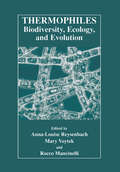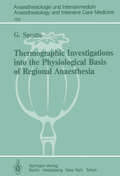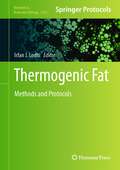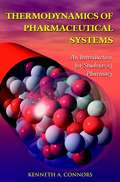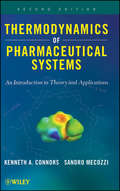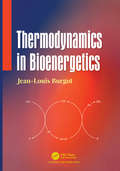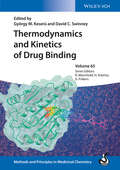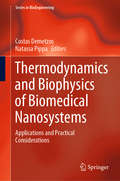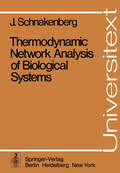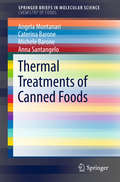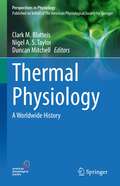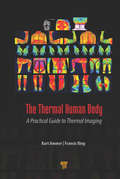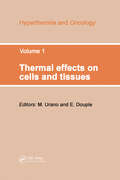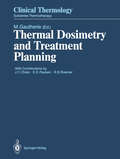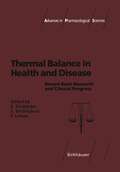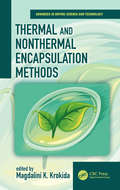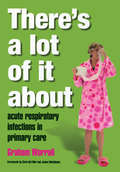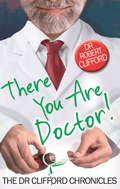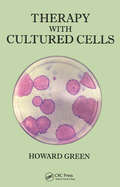- Table View
- List View
Thermophiles: Biodiversity, Ecology, and Evolution
by RoccoMancinelli MaryVoytek Anna-LouiseReysenbachThese are indeed exciting times to be a microbiologist. With one of the buzzwords of the past decade-"Biodiversity," and microbes are reveling in the attention as they represent by far most of the biodiversity on Earth. Microbes can thrive in almost any environment where there is an exploitable energy source, and, as a result, the possible existence of microbial life elsewhere in the solar system has stimulated the imaginations of many. Extremophiles have taken center stage in these investigations, and thermophiles have taken on the lead roles. Consequently, in the past decade there has been a surge of interest and research in the Ecology, Biology, and Biotechnology of microorganisms from thermal environments. Many of the foundations of thermophile research were laid in Yellowstone National Park, primarily by the research of Professor Thomas Brock's laboratory in the late 1960s and early 1970s. The upper temperature for life was debated, the first thermophilic archeum discovered (although it was only later shown to be an archeum by ribosomal cataloging), and the extremes of light, temperature, pH on the physiology of microorga nisms were explored. Interest in thermophiles increased steadily in the 1970s, and with the discovery of deep-sea hydrothermal vents in 1977, thermophilic research began its expo nential explosion. The development of Taq polymerase in the polymerase chain reaction (peR) focused interest on the biotechnological potential of thermophilic microorganisms and on the thermal features in Yellowstone National Park.
Thermographic Investigations into the Physiological Basis of Regional Anaesthesia (Anaesthesiologie und Intensivmedizin Anaesthesiology and Intensive Care Medicine #159)
by G. SprotteThermogenic Fat: Methods and Protocols (Methods in Molecular Biology #2662)
by Irfan J. LodhiThis volume presents a broad collection of state-of-the-art methods to study the biology of thermogenic fat using in vitro cell culture and animal models. Chapters guide the readers through protocols on differentiation of human pluripotent stem cells and murine adipocyte precursors; methods for measuring mitochondrial respiration, heat generation, brown fat activation, and effects on energy metabolism in mice; and techniques for AAV-mediated gene delivery, transplantation of adipose tissue, isolation of adipose tissue immune cells and extracellular vesicles, and mass spectrometry-based profiling of brown fat lipids. Written in the format of the highly successful Methods in Molecular Biology series, each chapter includes an introduction to the topic, lists necessary materials and methods, includes tips on troubleshooting and known pitfalls, and step-by-step, readily reproducible protocols. Authoritative and cutting-edge, Thermogenic Fat: Methods and Protocols aims to be comprehensive guide for researchers in the field.
Thermodynamics of Pharmaceutical Systems: An Introduction for Students of Pharmacy
by Kenneth A. ConnorsStudies of thermodynamics often fail to demonstrate how the mathematical intricacies of the subject relate to practical laboratory applications. Thermodynamics of Pharmaceutical Systems makes these connections clear, emphasizing specific applications to pharmaceutical systems in a study created specifically for contemporary curriculums at colleges of pharmacy. Students investigating drug discovery, drug delivery, and drug action will benefit from Kenneth Connors's authoritative treatment of the fundamentals of thermodynamics as well as his attention to drug molecules and experimental considerations. An extensive appendix that reviews the mathematics needed to master the pharmacy curriculum proves an invaluable reference. Connors divides his one-of-a-kind text into three sections: Basic Thermodynamics, Thermodynamics of Physical Processes, and Thermodynamics of Chemical Processes; chapters include: * Energy and the First Law of Thermodynamics * The Entropy Concept * Phase Transformations * Solubility * Acid-Base Equilibria * Noncovalent Binding Equilibria Thermodynamics need not be a mystery nor be confined to the realm of mathematical theory. Thermodynamics of Pharmaceutical Systems introduces students of pharmacy to the profound thermodynamic applications in the laboratory while also serving as a handy resource for practicing researchers.
Thermodynamics of Pharmaceutical Systems: An introduction to Theory and Applications
by Kenneth A. Connors Sandro MecozziDesigned for pharmacy students Now updated for its Second Edition, Thermodynamics of Pharmaceutical Systems provides pharmacy students with a much-needed introduction to the mathematical intricacies of thermodynamics in relation to practical laboratory applications. Designed to meet the needs of the contemporary curriculum in pharmacy schools, the text makes these connections clear, emphasizing specific applications to pharmaceutical systems including dosage forms and newer drug delivery systems. Students and practitioners involved in drug discovery, drug delivery, and drug action will benefit from Connors' and Mecozzi's authoritative treatment of the fundamentals of thermodynamics as well as their attention to drug molecules and experimental considerations. They will appreciate, as well, the significant revisions to the Second Edition. Expanding the book's scope and usefulness, the new edition: Explores in greater depth topics most relevant to the pharmacist such as drug discovery and drug delivery, supramolecular chemistry, molecular recognition, and nanotechnologies Moves the popular review of mathematics, formerly an appendix, to the front of the book Adds new textual material and figures in several places, most notably in the chapter treating noncovalent chemical interactions Two new appendices provide ancillary material that expands on certain matters bordering the subject of classical thermodynamics Thermodynamics need not be a mystery nor confined to the realm of mathematical theory. Thermodynamics of Pharmaceutical Systems, Second Edition demystifies for students the profound thermodynamic applications in the laboratory while also serving as a handy resource for practicing researchers.
Thermodynamics in Bioenergetics
by Jean-Louis BurgotThermodynamics in Bioenergetics aims to supply students with the knowledge and understanding of the critical concepts and theories that are needed in the biochemistry and bioenergetics fields. Biochemical reactions highlighting thermodynamics, chemical kinetics, and enzymes are addressed in the text. Author, Jean-Louis Burgot, guides the reader through the starting points, strategy description, and theory results to facilitate their comprehension of the theories and examples being discussed in the book. Also discussed in the text are the notions of Gibbs energy, entropy, and exergonic and endergonic reactions.
Thermodynamics in Bioenergetics
by Jean-Louis BurgotThermodynamics in Bioenergetics aims to supply students with the knowledge and understanding of the critical concepts and theories that are needed in the biochemistry and bioenergetics fields. Biochemical reactions highlighting thermodynamics, chemical kinetics, and enzymes are addressed in the text. Author, Jean-Louis Burgot, guides the reader through the starting points, strategy description, and theory results to facilitate their comprehension of the theories and examples being discussed in the book. Also discussed in the text are the notions of Gibbs energy, entropy, and exergonic and endergonic reactions.
Thermodynamics and Kinetics of Drug Binding (Methods and Principles in Medicinal Chemistry #65)
by Raimund Mannhold Hugo Kubinyi Gerd FolkersThis practical reference for medicinal and pharmaceutical chemists combines the theoretical background with modern methods as well as applications from recent lead finding and optimization projects. Divided into two parts on the thermodynamics and kinetics of drug-receptor interaction, the text provides the conceptual and methodological basis for characterizing binding mechanisms for drugs and other bioactive molecules. It covers all currently used methods, from experimental approaches, such as ITC or SPR, right up to the latest computational methods. Case studies of real-life lead or drug development projects are also included so readers can apply the methods learned to their own projects. Finally, the benefits of a thorough binding mode analysis for any drug development project are summarized in an outlook chapter written by the editors.
Thermodynamics and Kinetics of Drug Binding (Methods and Principles in Medicinal Chemistry)
by Raimund Mannhold Hugo Kubinyi Gerd FolkersThis practical reference for medicinal and pharmaceutical chemists combines the theoretical background with modern methods as well as applications from recent lead finding and optimization projects. Divided into two parts on the thermodynamics and kinetics of drug-receptor interaction, the text provides the conceptual and methodological basis for characterizing binding mechanisms for drugs and other bioactive molecules. It covers all currently used methods, from experimental approaches, such as ITC or SPR, right up to the latest computational methods. Case studies of real-life lead or drug development projects are also included so readers can apply the methods learned to their own projects. Finally, the benefits of a thorough binding mode analysis for any drug development project are summarized in an outlook chapter written by the editors.
Thermodynamics and Biophysics of Biomedical Nanosystems: Applications and Practical Considerations (Series in BioEngineering)
by Costas Demetzos Natassa PippaThis book highlights the recent advances of thermodynamics and biophysics in drug delivery nanosystems and in biomedical nanodevices. The up-to-date book provides an in-depth knowledge of bio-inspired nanotechnological systems for pharmaceutical applications. Biophysics and thermodynamics, supported by mathematics, are the locomotive by which the drug transportation and the targeting processes will be achieved under the light of the modern pharmacotherapy. They are considered as scientific tools that promote the understanding of physicochemical and thermotropic functionality and behavior of artificial cell membranes and structures like nanoparticulate systems. Therefore, this book focusses on new aspects of biophysics and thermodynamics as important elements for evaluating biomedical nanosystems, and it correlates their physicochemical, biophysical and thermodynamical behaviour with those of a living organism.In 2018, Prof. Demetzos was honored with an award by the Order of Sciences of the Academy of Athens for his scientific contribution in Pharmaceutical Nanotechnology.
Thermodynamic Network Analysis of Biological Systems (Universitext)
by J. SchnakenbergThis book is devoted to the question: What fundamental ideas and concepts can phys ics contribute to the analysis of complex systems like those in biology and ecolo gy? The book originated from two lectures which I gave during the winter term 1974/75 and the summer term 1976 at the Rheinisch-Westfalische Technische Hoch schule in Aachen. The wish for a lecture with this kind of subject was brought forward by students of physics as well as by those from other disciplines like biology, physiology, and engineering sciences. The students of physics were look ing for ways which might lead them from their monodisciplinary studies into the interdisciplinary field between physics and life sciences. The students from the other disciplines suspected that there might be helpful physical concepts and ideas for the analysis of complex systems they ought to become acquainted with. It is clear that a lecture or a book which tries to realize the expectations of both these groups will meet with difficulties arising from the different train ings and background knowledge of physicists and nonphysicists. For the physicists, I have tried to give a brief description of the biological aspect and significance of a problem wherever it seems necessary and appropriate and as far as a physicist like me feels authorized to do so.
Thermal Treatments of Canned Foods (SpringerBriefs in Molecular Science)
by Angela Montanari Caterina Barone Michele Barone Anna SantangeloThis Brief describes the chemical features of canned food products and gives background information on the technology of canning foods. It explains how canned foods are different from other packaged foods, and illustrates and discusses their unique properties, including risks and failures. Canned foods are usually considered to offer a particularly long shelf-life and durability. An understanding of their properties and influences on their durability is therefore of great importance in the industrial production, and this Brief offers a compact introduction to this topic.The authors focus on thermally-preserved foods. They explain that the right choice of thermal treatment method (e.g. pasteurisation, sterilisation) as well as process parameters (e.g. time, temperature) is additionally influenced by criteria such as pH, water content, the presence and concentration of fatty molecules, of calcium, etc. So-called ‘survival curves’ can help in determining the methodology of choice, and the Brief introduces the reader to this concept. The authors also address defects and failures. They introduce selected indicators, which can help identifying failures of the entire food/packaging system, and demonstrate how image and visual analysis can be applied in quality controls. The explanations and industrial production of canned foods are exemplified with the case of canned tomato sauces and beans.
Thermal Physiology: A Worldwide History (Perspectives in Physiology)
by Clark M. Blatteis Nigel A. S. Taylor Duncan MitchellThis edited volume records the critical historical developments in thermal physiology and makes them accessible to new and senior thermal biologists and scientists in related fields. Readers will discover how the discipline developed all over the world. Contributions from 14 different countries recollect all prominent discoveries, starting in the 18th century. Like other volumes of the Perspectives in Physiology series, this book reveals the people behind these discoveries. The authors also set the scenes in which the research was conducted in their countries. From geopolitical frameworks to new technologies and extraordinary personalities - this volume shows that scientific progress is influenced by many, often unforeseeable, factors. The history of thermal physiology not only is a story about individual outstanding scientists, but a testament for open collaboration and international comradery.
The Thermal Human Body: A Practical Guide to Thermal Imaging
by Kurt Ammer Francis RingThis book is a guide for the constantly growing community of the users of medical thermal imaging. It describes where and how an infrared equipment can be used in a strictly standardised way and how one can ultimately comprehensively report the findings. Due to their insight into the complex mechanisms behind the distribution of surface temperature, future users of medical thermal imaging should be able to provide careful, and cautious, interpretations of infrared thermograms, thus avoiding the pitfalls of the past. The authors are well-known pioneers of the technique of infrared imaging in medicine who have combined strict standard-based evaluation of medical thermal images with their expertise in clinical medicine and related fields of health management.
The Thermal Human Body: A Practical Guide to Thermal Imaging
by Kurt Ammer Francis RingThis book is a guide for the constantly growing community of the users of medical thermal imaging. It describes where and how an infrared equipment can be used in a strictly standardised way and how one can ultimately comprehensively report the findings. Due to their insight into the complex mechanisms behind the distribution of surface temperature, future users of medical thermal imaging should be able to provide careful, and cautious, interpretations of infrared thermograms, thus avoiding the pitfalls of the past. The authors are well-known pioneers of the technique of infrared imaging in medicine who have combined strict standard-based evaluation of medical thermal images with their expertise in clinical medicine and related fields of health management.
Thermal Effects on Cells and Tissues
by M. Urano E. DoupleVolume 1 of Thermal Effects on Cells and Tissues covers Hyperthermia and Oncology. This is a collection of eight essays.
Thermal Effects on Cells and Tissues
by M. Urano Evan B. DoupleVolume 1 of Thermal Effects on Cells and Tissues covers Hyperthermia and Oncology. This is a collection of eight essays.
Thermal Dosimetry and Treatment Planning (Clinical Thermology)
by John C. Chato Keith D. Paulsen Robert B. RoemerWhen in the future improved and more flexible heating equipment becomes available, and when hyperthermia is applied more routinely, computerized simulations of treatments will become commonplace, as they are in radia tion therapy. For hyperthermia, however, such simulations will be used not only for the traditional role of planning patient treatment, but also for three other applications not needed in radiation therapy - the comparative evalu ation of equipment, feedback control during treatment, and the post-treat ment evaluation of therapy. The present simulations of hyperthermia are crude and simple when compared with what is required for these future ap plications, a fact which indicates the nedd for considerable research and de velopment in this area. Indeed, this research is proceeding rapidly within the hyperthermia community, whre three-dimensional power deposition and temperature calculations have just become available for realistic patief\t anatomies. Of equal significance are the even more rapid development in diagnostic imaging for the determination and display of patient anatomy and blood flow rates - information required for the planning of realistic hyperthermia treatment. These simulations will be very valuable tools which can be used to great ad vantage when combined with data obtained from treatments of patients.
Thermal Balance in Health and Disease: Recent Basic Research and Clinical Progress (Advances in Pharmacological Sciences)
by Eugen Zeisberger Eduard Schönbaum Peter LomaxThermal and Nonthermal Encapsulation Methods (Advances in Drying Science and Technology)
by Magdalini KrokidaEncapsulation is a topic of interest across a wide range of scientific and industrial areas, from pharmaceutics to food and agriculture, for the protection and controlled release of various substances during transportation, storage, and consumption. Since encapsulated materials can be protected from external conditions, encapsulation enhances their stability and maintains their viability. This book offers a comprehensive review of conventional and modern methods for encapsulation. It covers various thermal and nonthermal encapsulation methods applied across a number of industries, including freeze drying, spray drying, spray chilling and spray cooling, electrospinning/electrospraying, osmotic dehydration, extrusion, air-suspension coating, pan coating, and vacuum drying. The book presents basic fundamentals, principles, and applications of each method, enabling the reader to gain extended knowledge. The choice of the most suitable encapsulation technique is based on the raw materials, the required size, and the desirable characteristics of the final products.
Thermal and Nonthermal Encapsulation Methods (Advances in Drying Science and Technology)
by Magdalini KrokidaEncapsulation is a topic of interest across a wide range of scientific and industrial areas, from pharmaceutics to food and agriculture, for the protection and controlled release of various substances during transportation, storage, and consumption. Since encapsulated materials can be protected from external conditions, encapsulation enhances their stability and maintains their viability. This book offers a comprehensive review of conventional and modern methods for encapsulation. It covers various thermal and nonthermal encapsulation methods applied across a number of industries, including freeze drying, spray drying, spray chilling and spray cooling, electrospinning/electrospraying, osmotic dehydration, extrusion, air-suspension coating, pan coating, and vacuum drying. The book presents basic fundamentals, principles, and applications of each method, enabling the reader to gain extended knowledge. The choice of the most suitable encapsulation technique is based on the raw materials, the required size, and the desirable characteristics of the final products.
There's a Lot of it About: v. 2, Private Life
by Graham Worrall Chris Del Mar Sir Liam DonaldsonThis book contains forewords by Chris Del Mar and James Hutchinson respectively - Dean, Faculty of Health Sciences and Medicine, Bond University, Australia; Chief of Infectious Diseases Control, Memorial University of Newfoundland, Canada. Acute respiratory infections make up a quarter of all primary care consultations. This book is the ideal quick reference and teaching aid. In presenting best evidence on the epidemiology, causes and management of the most common acute respiratory infections, this book gathers together a wealth of previously scattered original research and information and offers solutions for practical application. It is concise, clear and easy to use. Primary care professionals, including doctors, nurses and health visitors will find it invaluable, as will general practitioners in training. 'There is much more to these diseases than most of us realise. It will not take you long to find fascinating and useful material here. It makes for a very interesting read. The evidence about management, as well as diagnosis, is very important. Acute respiratory infection is one of the famously important areas in which mistaken beliefs by not only our patients, but also us doctors, of the benefits of antibiotics makes to the contribution of bacterial resistance. Graham Worrall has highlighted new forms of treatment we often forget when we reach for the pad to write another 'safety' prescription for antibiotic. There is a wealth of information here.' - Chris Del Mar, in his Foreword. 'An objective, thoughtful treatment of a subject that accounts for a large part of a primary care physician's working life but inexplicably little of his or her training. Thorough evaluation of the literature, often exposing huge gaps in the study of these extremely common conditions, will serve as an impetus for study and a guide to rational decision-making. The straightforward approach with excellent practical distillations of the evidence and resulting recommendations is perfect for the busy physician or busy student. As someone who teaches medical students about infections I have longed for a concise resource to support my efforts at encouraging prudent antibiotic prescription for respiratory tract infections. I long no more.' - James Hutchinson, in his Foreword.
There's a Lot of it About: v. 2, Private Life
by Graham Worrall Chris Del Mar Sir Liam DonaldsonThis book contains forewords by Chris Del Mar and James Hutchinson respectively - Dean, Faculty of Health Sciences and Medicine, Bond University, Australia; Chief of Infectious Diseases Control, Memorial University of Newfoundland, Canada. Acute respiratory infections make up a quarter of all primary care consultations. This book is the ideal quick reference and teaching aid. In presenting best evidence on the epidemiology, causes and management of the most common acute respiratory infections, this book gathers together a wealth of previously scattered original research and information and offers solutions for practical application. It is concise, clear and easy to use. Primary care professionals, including doctors, nurses and health visitors will find it invaluable, as will general practitioners in training. 'There is much more to these diseases than most of us realise. It will not take you long to find fascinating and useful material here. It makes for a very interesting read. The evidence about management, as well as diagnosis, is very important. Acute respiratory infection is one of the famously important areas in which mistaken beliefs by not only our patients, but also us doctors, of the benefits of antibiotics makes to the contribution of bacterial resistance. Graham Worrall has highlighted new forms of treatment we often forget when we reach for the pad to write another 'safety' prescription for antibiotic. There is a wealth of information here.' - Chris Del Mar, in his Foreword. 'An objective, thoughtful treatment of a subject that accounts for a large part of a primary care physician's working life but inexplicably little of his or her training. Thorough evaluation of the literature, often exposing huge gaps in the study of these extremely common conditions, will serve as an impetus for study and a guide to rational decision-making. The straightforward approach with excellent practical distillations of the evidence and resulting recommendations is perfect for the busy physician or busy student. As someone who teaches medical students about infections I have longed for a concise resource to support my efforts at encouraging prudent antibiotic prescription for respiratory tract infections. I long no more.' - James Hutchinson, in his Foreword.
There You Are, Doctor!: "there You Are, Doctor!", "on Holiday Again, Doctor?", "you're Still A Doctor, Doctor!" (The Dr Clifford Chronicles)
by Dr Robert CliffordAs charming as he is entertaining, Dr Robert Clifford dispenses a delightful dose of hilarious anecdotes, colourful portraits of patients, family and friends, tempered with heartwarming tales of human courage and tragedy.There's the eccentric hermit Hamish Richardson; the stubborn Romany Zackovitch Hebden; Miss Peabody, the elderly spinster ever hopeful of a pools win; and William Jessop, the blind man whose handicap obviously isn't a handicap! As well as stories from his Tadchester surgery, Dr Robert Clifford tells of his son's accident on Sark and there are more fishy tales with water bailiff John Denton and a sparkling of delightful descriptions of holidays at home and abroad.Doctor, family man, humourist, philosopher and counsellor, Dr Robert Clifford's stories are a tonic for us all.
Therapy with Cultured Cells
by Howard GreenIn this book the author describes the discoveries in his laboratory that led to therapy with cultured cells. The first cultured cell type used for therapy was the keratinocyte of the epidermis, for the treatment of burns. Subsequent developments led to the use of cultured cells for the treatment of diseases of the eye, of the joints and of other diseases. Cultured cells for therapy are now being prepared by industries in the US, Japan and Korea and are used in the aforesaid countries, as well as in France, Sweden and Greece, for the treatment of disease.
